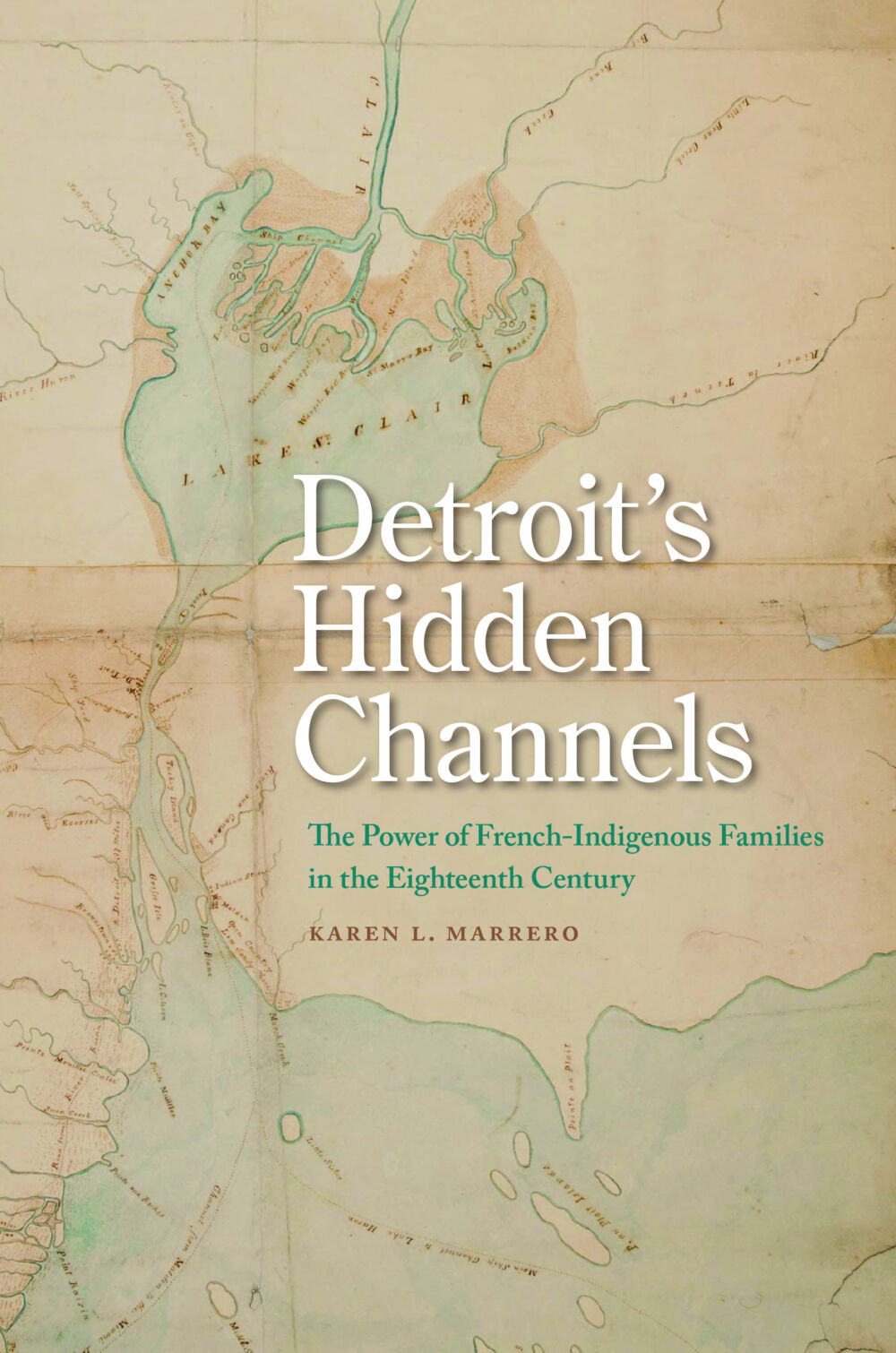Excerpt from Detroit’s Hidden Channels: The Power of French-Indigenous Families in the Eighteenth Century
“Speaking Silences and Divulging Secrets: Toward a Recovery of Detroit’s French-Indigenous History”
It was the only time the genealogist who had assembled the LaBute family history in 1977 interrupted her recitation of people, places, and dates. Her bold statement was an attempt to explain away the appearance of a woman named Marie Magdelene Roy, daughter of Pierre Roy and Marguerite Ouabankikoué, the latter listed as being “of Indian descent.” Marie Magdelene had been born May 25, 1710, in Detroit, married to Pierre Labutte in 1728 at Fort Miamis, and buried November 20, 1732, in Detroit.


The genealogist came out from behind familial details to deliver her opinion clearly and with conviction: “Marie Madeleine was of French descent, you are what your father is, not what your mother is or was, her father Pierre Roy was French.”
In one bold stroke, Marie Magdelene had been changed from being of mixed Indigenous and European blood and culture, to French, and had been shorn of half her ethnic identity. Her mother Marguerite’s presence had been revealed, only to be erased. Both women were “hidden in plain view” beneath a “facade of whiteness” within a genealogy, where lives circulate outside traditional on submerging an Indigenous past and recording only those lines drawn between histories of wars and nations.
The women were also doubly subjugated, or buried twice, by a society bent on submerging an Indigenous past and recording only those lines drawn between fathers across time. It was a racialized and gendered forgetting, because Indigenous bloodlines that intertwined with those of Europeans could be traced back in almost every instance to an Indigenous woman. In many of these cases, there had never been a marriage according to Christian rites, which further disturbed or introduced the possibility of dispute into genealogies. By literally “rooting out” these women, genealogies preserved the illusion of an endless and unbroken chain that linked a dynasty of white men.
The only reason Marguerite and Magdelene had appeared in this genealogy was because Magdelene had been married in the Roman Catholic Church. An integral part of this erasure also involved the tendency to romanticize cross-cultural sexual encounters, rather than exploring the full range of experiences of Indigenous and mixed-blood women, including the violence they could suffer at the hands of Euro-American men.
But for whose supposed greater good or collective well-being was the keeping of this secret demanded? Had the rough edge of Magdelene’s and Marguerite’s indigeneity been chiseled away for the construction of a seamless national history of Canada or of the United States, or of an Anglo-Canadian or French-Canadian ethnic identity? These exclusions in historical narratives, or “acts of oblivion” involve deliberate suppression of memories of people, places, and events in the interest of “social cohesion.” Each of these types of narratives, according to historian Michel-Rolph Trouillot, are unique in being “a particular bundle of silences” that “crisscross or accumulate over time to produce a unique mixture.” I wanted to look closely enough to find the almost invisible seams or scars in the complex narrative of Detroit’s French-Indigenous community and discover a method by which I could open those seams, pulling the whole apart and revealing the distinct and messy collection of secrets inside.
If family history had been the mechanism for the creation of silences, perhaps now it could be the means of restoring those who had been marginalized and resituating them in the larger context of European and Indigenous relations at Detroit and in the Great Lakes in the eighteenth century. Familial narratives could be viewed as “community talk” used as a protective mechanism to counter the force of a “supposedly universal history” or national narrative that threatens to engulf individuals and localities. Geographer Nicholas Entrikin proposes that “place is best viewed from points in between” the local and the universal. Otherwise, either the significance of historical subjects becomes lost in “generic relations,” or too close a focus on those subjects makes it difffijicult to connect them to the larger meaning-making systems of which they were a part.
Reintegrating marginalized historical agents also means reintegrating genealogies into standard histories and, in the case of French-Indigenous family history, turning those genealogies inside out by connecting the dots between women across time. It was in the “gendered and racialized intimacies of the everyday” that European empires sought to turn individuals into colonial subjects even as the same sites of intimacy provided cover from these efforts, frustrating imperial agents. As historian Ann McGrath has pointed out, marriages across colonizing boundaries created family histories and “expansive diasporic connections” that remain outside the parameters of traditional historical narratives. In her research on mixed-blood communities, historian Heather Devine found that because “kin obligations generally superseded other commitments,” genealogical materials reveal sociopolitical alliances, migrations of individuals and their families across regions, and socioeconomic status of families.
There has been another layer of secrecy that has obscured the historic roles of French-Indigenous families of the Great Lakes and of southwestern Ontario and southeastern Michigan in particular. Indigenous and mixed-blood histories are predominantly oral, which, according to historian Carolyn Podruchny, have left few records and makes the study of their cultures a challenge. Scholars working on reintegrating these peoples have adopted alternative methodologies, including the study of folksongs combining French and Indigenous (Anishinaabowin and Iroquoian) lyrics, because their historical agents are often missing from traditional sources. These auditory artifacts document cultural change over time. Also, the stories they tell, “like good theories, make connections that may not at first glance seem straightforward.”
Charting the history of Detroit’s French-Indigenous kinship networks requires an understanding of how community knowledge developed relative to empire. The complexities of this relationship are readily apparent when we compare the dueling narrative trajectories generated at the level of the state on one hand and at the local level on the other. Local knowledge is comprised of what James Scott describes as a “wide array of practical skills and acquired intelligence in responding to a constantly changing natural and human environment.” The state is constantly attempting to destroy, control, or appropriate this highly adaptive knowledge in an effort to exert “administrative order.” The state’s account minimizes, sometimes deliberately and sometimes out of ignorance, the power and authority of local persons and networks. The local, often frustrated imperial agents who served time-limited terms in their administrative positions were bent on quickly maximizing their career and earning opportunities, and therefore sought to read and exploit local resources as quickly and easily as possible.
There are numerous examples of this tendency in the French and British imperial records of eighteenth-century Detroit. One such case appears in the voluminous correspondence of Antoine de la Mothe Cadillac, Detroit’s first French commandant. By focusing on the name of one fur trader named Pierre Roy, who we met briefly at the beginning of this chapter, it becomes clear that Cadillac either misunderstood the culture of French-Indigenous family networks he lived among at Detroit, or knowingly misrepresented this man’s role in order to elicit sympathy in the eyes of Cadillac’s superiors and better his chances at monetary compensation. Whether the distortion was deliberate or not, it constitutes a form of erasure perpetrated by Cadillac that has a profound effect on the way we read those records and contextualize the history of local persons and events in Detroit.
By following Pierre Roy through the correspondence of Cadillac and other imperial agents, it is possible to recover a trail that stretched across New England, New York, Montreal, New Orleans, and Indigenous nations, including the Myaamia, Mascouten, Meskwaki, Haudenosaunee, Wendat, and Odawa/Anishinaabe. The extended Roy family appears consistently in French and British records and in the correspondence of imperial agents such as Cadillac and British superintendent of Northern Indian Affairs Sir William Johnson. A Monsieur Roy also appears in oral testimony, in a song about the Mascouten—a western Great Lakes Algonquian nation that figured in Detroit’s early eighteenth-century history—still sung in the twentieth century by local French residents of the Detroit and Windsor area. Scholars have largely ignored these seemingly “peripheral” persons and their connections to Detroit’s history.
In addition to recovering instances of tension between local peoples and the empires attempting to control them, it is also necessary to understand if, when, and how these tensions were resolved. The intricacies of the relationship between the two could be complicated depending on whether they sought to work, if even temporarily, toward a shared purpose and successfully managed antagonisms. Historic moments at which the two were in opposition, both in their purpose and the manner in which this purpose was perceived to be best attained, are equally telling. Historian Sheldon Pollock points out that the state can practice “coercive cosmopolitanism” and the local community a “vernacularism of necessity.”
Thus, individuals can be compelled to participate in the larger world of the state while an equal level of participation can be demanded, based on family ties, in the smaller world of the local community. Conversely, there are other times at which the state practices a “voluntaristic cosmopolitanism” and the local community a “vernacularism of accommodation,” in each case inviting, rather than compelling, “affiliation to these cultural-political orders.” The implications are that the loyalty of an individual or family in the eighteenth century could be engaged by both an imperial power and the local community in a variety of ways that sometimes worked at cross-purposes.
The description of local peoples in imperial archives reflected whether they were cooperating with or challenging imperial (be this Indigenous or Euro-Ameri- can polities) strictures. The French imperial state, for example, marginalized French traders or designated them as other with the moniker “coureurs de bois” if these individuals were perceived to be operating illegally or in opposition to the state. This same French state distinguished Indigenous nations based on whether or not they were in alliance with the French king. Add to this the fact that in the early modern period, when regionally based concepts of collective identity prevailed over an incipient sense of French nationhood, it is as anachronistic to insist on a single, global French identity for persons residing in and moving across the North American continent as it is to posit a generic Indigenous nationhood.
Virtual Book Launch of Detroit’s Hidden Channels
Please join us for the virtual launch Detroit’s Hidden Channels on Thursday, September 17, featuring Karen L. Marrero with guests Kathryn Magee Labelle and Guillaume Teasdale.
Register here: https://us02web.zoom.us/webinar/register/WN_1zlAKGGeSnOAL9A4_GvMuA
Posted by Karen L. Marrero
September 14, 2020
Categorized as Excerpt, Author Posts
Tagged anishinaabe, community, detroit, french-indigenous, history, identity, indigenous, michigan, migration, ontario, transnational, women
Manitoba 150 Excerpt #6: Creating Space Call to Action 6
